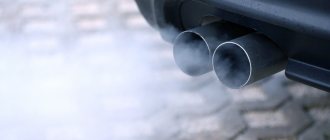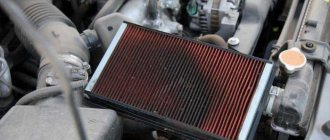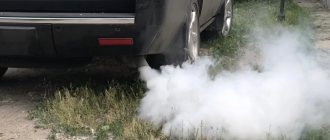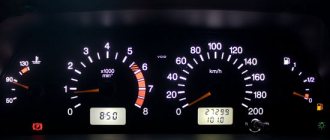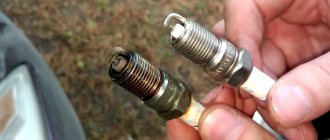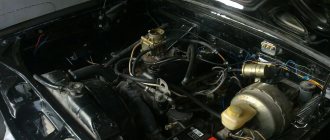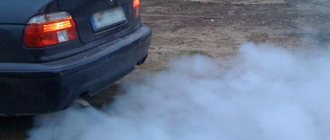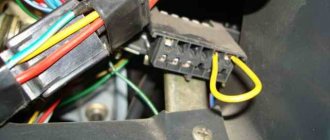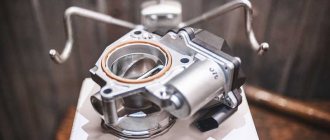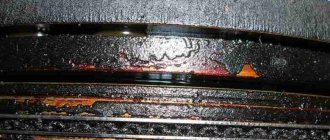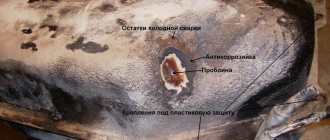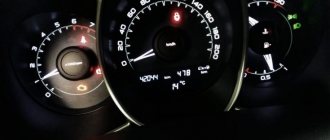Operation / From Autoclub
- The nature of smoke and the degree of wear of the power unit
- The main reasons for the appearance of blue smoke from a car muffler
Piston ring defects
- Violation of cylinder dimensions
- Cylinder defects
While the car is new, few people pay attention to the condition of the exhaust gases and think that problems can be determined by their color. However, over time, especially if you do not pay due attention to vehicle maintenance, a more experienced neighbor in the garage will tell you about the appearance of a non-standard exhaust. Knowing the reasons for this phenomenon will certainly help to avoid unpleasant moments in the future, especially when buying a used car. What useful information on the topic is contained in the article:
- The nature of the appearance of unusually colored exhausts
- The relationship between the appearance of smoke and wear of the power unit
- Overview of the reasons for the appearance of blue (gray) exhaust
- Piston ring defects
- Violation of cylinder dimensions
- Cylinder defects
- Non-standard fault options
- conclusions
The nature of the appearance of bluish smoke from a car exhaust pipe
An unusual color of exhaust gases always means that one of the vehicle's systems or components is faulty.
Based on simple observation, it is possible to determine the breakdown of a certain mechanism. If, for example, a white exhaust indicates the presence of coolant in the cylinders, and a black indicates a supersaturated mixture, then the main reason for blue smoke from the muffler is oil combustion in the internal combustion engine . This is where its name comes from - “oil”, which indicates serious problems with the engine.
At the same time, it must be taken into account that exhaust gases can have different shades, and this depends on many factors, including:
- degree of engine warm-up;
- composition and quality of motor oil;
- number of revolutions;
- external light conditions and ambient air humidity.
It is obvious to assume that “oily” exhaust is certainly accompanied by increased consumption of engine oil. This is actually true, for example, if at a standard consumption of 10 g per 100 km, blue smoke from the exhaust pipe appears only in transient modes, then exceeding the operating standards for oil consumption (ICE wear) will be expressed in the same way, only now in constant motion mode.
Unburned fuel
This guess will be confirmed by the presence of a pungent and pungent odor from the exhaust system. This will mean that the unburned fuel comes out along with the smoke in a vapor state.
Fuel may not burn out for various reasons. It is possible that the fuel is supplied too late or that some cylinder does not cope with its task and cannot burn diesel fuel.
As a rule, every effect has causes. The consequence, in this case, is unburned fuel and, as a result, the diesel smokes blue. So what are the reasons and malfunctions in diesel components that can lead to this?
Injection pump faulty
If the cause of blue smoke is a delayed injection, then you should pay attention to the wear of the high pressure fuel pump (HPF). It is easy to guess that the fuel will not have time to burn out if it is supplied late.
So, we have decided on one of the possible culprits. But why does this happen? The design and operation of the injection pump is quite complicated. To explain in simple words, the operation of this unit is based on the movement of special mechanisms for supplying fuel, which constantly rub and contact each other.
The fuel itself serves as a lubricant for the parts. Quite a tricky solution, because diesel fuel has a greasy structure. But with the arrival of winter, a transition to winter fuel is made.
It is called winter because its viscosity is reduced, namely, those same lubricating fractions are missing or their quantity is not enough to lubricate the “hardware” in the pump. This is what causes the fuel injection pump to wear out. And the wear of this part of the unit, in turn, along with the profile of the wave washer, causes a delay in fuel injection.
The mechanism is as follows: the fuel does not have time to heat up because it is supplied late, and the cylinder begins to work poorly with surges. As a result, the fuel that does not have time to burn is released outside in the form of blue smoke.
If you warm up the engine after driving a few kilometers, the bluish trail behind the car will disappear or decrease so much that it cannot be traced. But pump problems will not be corrected by this. When the engine is warm, even fuel supplied late has time to burn almost completely due to the high temperature background.
Poor engine compression
There are times when strong blue smoke comes out when starting the engine. And then after proper warming up the smoke disappears. This picture is quite common in the courtyards of our country, when there are columns of smoke, and the driver is running, clutching his head, and cannot understand what is happening.
The reason for this is low engine compression. Due to this defect, the temperature during compression does not reach the required value, so the fuel does not burn out completely. Even if the engine has one cylinder with low compression, the operation of such an engine is possible. But it will smoke until the overall temperature rises and the faulty cylinder begins to cope with the incoming fuel and ignite it.
Blue smoke can be caused by untimely injection or low compression. By the way, most modern diesel engines are equipped with a device on the fuel pump that performs early injection when the engine is still cold.
With this function, the engine runs harder, but the fuel has time to burn completely. The engine heats up, and the device returns fuel injection to its initial state, the engine begins to “purr” and becomes pleasant and soft to the ear.
The nature of smoke and the degree of wear of the power unit
Experienced specialists, based on their own observations or the client’s descriptions of the characteristics of smoke, can with a high degree of probability guess the nature of the problem. Let's look at a few common cases :
- If the blue-white exhaust appears only when the engine warms up and gradually disappears as it warms up, then there is no reason to fear serious wear of the mechanisms. This effect is explained by the ability of parts to expand; when heated, the gaps decrease and oil leakage stops.
- In the case when, after warming up the power unit, smoking not only continues, but also intensifies, it can be argued that there is significant wear of the internal combustion engine elements. The reason is the following - the expansion is not enough to reliably seal the gaps and through them hot oil easily penetrates into the cylinders.
It goes without saying that blue or blue-white smoke from the muffler is accompanied by increased oil consumption. Therefore, monitoring its level using a dipstick is a necessary operation, which makes it possible to determine a breakdown in the early stages of its occurrence. Exceeding the consumption rate of lubricants should immediately alert the owner. In addition, on modern cars, due to the fact that they are equipped with a neutralizer that can purify gases, it is not always possible to determine the color of the exhaust even with increased oil consumption.
We must not forget about such a phenomenon as compression, the degree of which can sometimes be misleading. So, at first glance, wear of the CPG elements is quite often characterized by loss of compression and increased crankcase gas pressure. However, at the same time, a significant amount of oil seals the gaps and if they are not very far from standard, then the compression gauge readings may be normal, and sometimes closer to the upper limit.
The main reasons for the appearance of blue smoke from a car muffler
An owner who knows the slightest bit about how a car works knows that oil can get into the combustion chamber only in two ways:
- through piston rings;
- through the gap between the guide bushings and the valve stems.
From here we can already identify several groups of reasons why bluish smoke appears from the exhaust pipe and oil consumption increases:
- change in cylinder geometry;
- piston ring defects;
- scoring on the cylinder surface;
- wear of the oil seal;
- valve leakage.
Let's take a closer look at some of the reasons from the list above.
Piston ring defects
One of the most common reasons leading to excessive consumption of lubricant. Compression rings wear out not only on the outer planes, but also on the end planes due to the high gas pressure in the cylinder. Moreover, worn grooves of the structure can create a “pump” effect, i.e. pump oil directly into the cylinder, even if the oil scraper rings are fully functional.
Violation of cylinder dimensions
Cylinders often wear out where the top ring stops when the piston reaches TDC. Also in the middle region of the cylinder, changes in its geometry towards an ellipse are observed. When carrying out diagnostics, it is important to accurately determine all deviations of the cylinder from the circle; this is the only way to get rid of the fact that blue smoke is coming from the muffler and excessive oil consumption is noticed. To do this, a series of independent measurements are made:
- in two vertical planes of the cylinder;
- in four levels horizontally of the node.
Cylinder defects
Unpleasant things like scuffs and scratches on the cylinder bore also allow oil to penetrate. The causes of such defects may be:
- abrasive particles due to unsatisfactory filtration of the lubricant;
- long-term parking of the car, as a result of which corrosion may occur on the rings and cylinders;
- non-compliance with power plant repair technology and the use of low-quality parts.
Why is black smoke dangerous when accelerating?
Diesel smokes black smoke in the case of an over-enriched mixture, when the air entering the cylinders is not enough for complete combustion of the injected portion of fuel. Often, thick black smoke is observed during sudden throttle changes, intense acceleration, or when driving under load. The main reasons for increased smoke:
- Insufficient air entering the intake manifold. A lack of oxygen can be caused by a clogged air filter, a leak in the intake tract, or a malfunction of the turbocharger.
- Excessive fuel supply. Most often, the cause of overflow lies in faulty injectors, but a similar situation is possible in the event of improper operation of the mass air flow sensor or absolute pressure sensor (DBP). If the sensor readings do not correspond to the actual amount of air entering the intake tract, the ECU (Engine Control Module) is not able to select the correct amount of fuel. The mixture turns out to be over-enriched, which is why black exhaust from the diesel engine is observed.
- Changing the timing and duration of fuel injection. The reason may be either faulty injectors or control. The timing of injection and the duration of the open state of the injectors can be affected by incorrect operation of the sensors that record the load on the engine (mass air flow sensor, DBP, gas pedal position sensor), as well as changes in the ECU firmware. When chip tuning, changes to the fuel map are made intentionally to increase the power of the diesel engine.
- EGR valve stuck in open position. Incomplete blocking of the exhaust gas return channel leads to a decrease in temperature in the combustion chamber. If the EGR valve does not close completely under full load, the air-fuel mixture does not burn completely and black smoke comes out of the pipe.
- Low quality diesel fuel.
- Incorrect installation of timing marks.
A general violation of the cyclic fuel supply or uneven fuel supply between the cylinders leads to increased loads on the parts of the cylinder-piston group, the crankshaft and its liners. Significant overflow can destroy the piston partitions and cause scuffing on the liners, which will subsequently lead to them turning over.
Non-standard fault options
When it comes to turbocharged engines , symptoms of discoloration of the exhaust may be associated with wear on the compressor rotor seals and bearings . At the same time, a defect in the seal of the front bearing of the turbocharger gives a characteristic picture, which is similar in external factors to wear of oil seals, including carbon deposits on the spark plugs. It is somewhat more difficult to determine the failure of the turbine seal due to the direct entry of oil into the exhaust system, where it burns out.
Quite rarely, but still occurs, a malfunction of the automatic transmission regulator membrane (if there is a vacuum load sensor). This also leads to a phenomenon such as blue smoke from the exhaust pipe; the defect can be determined by the condition of the spark plugs, which are filled with oil, as well as the splashing of lubricant from the spark plug mounting holes. Box oil has a reddish color and a specific smell - this is what will help diagnose a breakdown.
What to do if the engine smokes when cold
You can find the cause by performing a series of sequential checks:
- check how much the car has driven since the last oil change - perhaps the deadline has expired and the fluid needs to be replaced;
- measure the compression and inspect the rings - to eliminate the defect, decarbonize and change the oil;
- assess the condition and, if necessary, replace the valve stem seals;
- make sure the fuel injectors are working;
- check and repair (if necessary) the USR valve, fuel injection pump.
To carry out diagnostics, it is recommended to choose proven service stations.
Eventually
Operating a car with blue exhaust is not only uncomfortable for those around you and passengers, but is also extremely detrimental to the components of the car. Therefore, at the first sign of an atypical exhaust, you should analyze the situation yourself or contact a specialist.
The reason should be sought in components that are actively in contact with oil, and this is, first of all, the cylinder-piston group, automatic transmission with a vacuum load sensor, and also the turbocharger.
Causes of transmission oil leaks and ways to eliminate them
What is engine detonation and what are the causes of its occurrence?
Parting recommendations
If diagnostic results are unsatisfactory, experienced owners usually act by elimination. First, an attempt is made to decarbonize the oil scraper rings. If this is your first time encountering this concept, we recommend reading about what decarbonization is and why the engine needs it, as well as about the technology for decaburning piston rings using dimexide, as one of the inexpensive and effective means.
If an attempt to remove coke does not bring results, then work is planned on the cylinder head. If replacing the valve stem seals is unsuccessful, then a “overhaul” is performed.
Source
